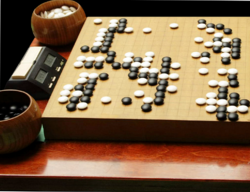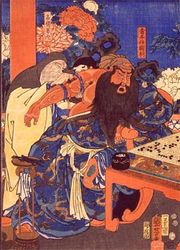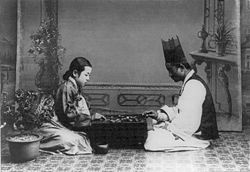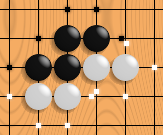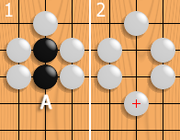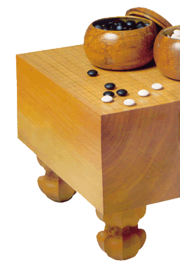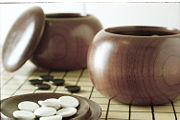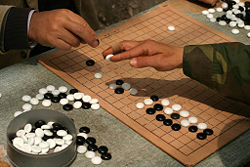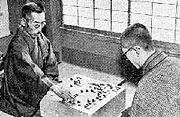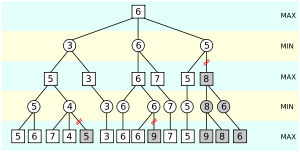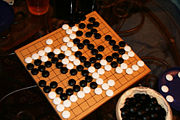Go (board game)
2008/9 Schools Wikipedia Selection. Related subjects: Games
Go is a strategic board game for two players. It is known as wéiqí in Chinese ( Traditional: 圍棋; Simplified: 围棋), igo (囲碁 ?) or go (碁 ?) in Japanese, and baduk in Korean ( hangul: 바둑). To differentiate it from the common English verb go, it is sometimes capitalized. An alternate spelling is also used occasionally. Go originated in China, where it has been played for at least two thousand years. It is mostly popular in East Asia but has nowadays gained some popularity in the rest of the world as well. Go is noted for being rich in strategic complexity despite its simple rules.
Go is played by two players alternately placing black and white stones on the vacant intersections of a 19 × 19 grid board. The object of the game is to control a larger part of the board than the opponent. To achieve this, players strive to place their stones in such a way that they cannot be captured, while mapping out territories the opponent cannot invade without being captured. A stone or a group of stones is captured and removed if it has no empty adjacent intersections, the result of being completely surrounded by stones of the opposing colour.
On one hand, placing stones close together helps them support each other and avoid capture. On the other hand, placing stones far apart creates influence across more of the board. Part of the strategic difficulty of the game stems from finding a balance between such conflicting interests. Players strive to serve both defensive and offensive purposes and choose between tactical urgency and strategic plans. The game ends, and the score is counted when both players consecutively pass on a turn, indicating that neither side can increase its territory or reduce its opponent's.
Despite the fact that Go originated in ancient China, it is commonly known in the West by its Japanese name, go. This stems from the fact that early Western players learned of the game from Japanese sources. As a result, many Go concepts for which there is no ready English equivalent have become known elsewhere by their Japanese names. The Japanese name igo is linked to the Japanese reading of its Chinese name weiqi, which roughly translates as "board game of surrounding".
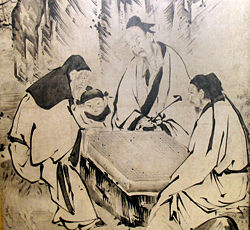
| This article contains Chinese text. Without proper rendering support, you may see question marks, boxes, or other symbols instead of Chinese characters. |
| This article contains Japanese text. Without proper rendering support, you may see question marks, boxes, or other symbols instead of kanji or kana. |
| This article contains Korean text. Without proper rendering support, you may see question marks, boxes, or other symbols instead of Hangul or hanja. |
History
Origin in China
Some legends trace the origin of the game to legendary Chinese emperor Yao (2337–2258 BC), who had his counselor Shun design it for his son, Danzhu—supposedly an unruly sort—to teach him discipline, concentration, and balance. Other theories suggest that the game was derived from Chinese tribal warlords and generals who used pieces of stone to map out attacking positions or that Go equipment was originally a fortune telling device.
The earliest written reference of the game is usually taken to be the historical annal Zuo Zhuan (c. 4th century BC), referring to a historical event of 548 BC. It is also mentioned in Book XVII of the Analects of Confucius (c. 3rd century BC) and in two of the books of Mencius (c. 3rd century BC). In all of these works, the game is referred to as yì (弈), a name that means "to play (Go)" today.
Go was originally played on a 17 × 17 grid, but a 19 × 19 grid became standard by the Tang Dynasty (618-907).
In China, Go was perceived as the popular game of the aristocracy, while Xiangqi (Chinese chess) was the game of the masses. Go was considered one of the four cultivated arts of the Chinese scholar gentleman, along with calligraphy, painting and playing the musical instrument guqin.
Spread to Japan and Korea
Although Go may have reached Korea as early as the 5th century AD, more solid evidence stems from the 7th century AD. By this time, Go had also reached Japan, where it gained popularity at the imperial court in the 8th century. By the beginning of the 13th century, Go was played among the general public in Japan.
In 1603, Tokugawa Ieyasu re-established Japan's unified national government. In the same year, he assigned the then-best player in Japan, a Buddhist monk named Nikkai (born Kano Yosaburo, 1559), to the post of Godokoro (Minister of Go). Nikkai took on the name of Honinbo Sansa and founded the Honinbo Go school. Several competing schools were founded soon after. These officially recognized and subsidized Go schools greatly developed the level of play and introduced the dan/kyu style system of ranking players. Players from the four schools (Honinbo, Yasui, Inoue, Hayashi) competed in the annual castle games, played in the presence of the shogun.
Go In The West
Despite its widespread popularity in Eastern Asia, Go has been slow to spread to the rest of the world, unlike other games of ancient Asian origin such as chess. Schadler speculates that chess has more widespread appeal because on the one hand culturally congruent game pieces can be created in chess (e.g. Queen and Bishop in Western Chess, but Advisor and Elephant in Chinese Chess), and on the other hand there is no climactic ending in Go (such as checkmate in chess); indeed, new players often have trouble figuring out when a game of Go is over.
The first detailed description of Go in a European language, De Circumveniendi Ludo Chinensium ('About the Chinese encircling game'), was written in Latin by Thomas Hyde, and included in his 1694 treatise on Oriental board games, De Ludis Orientalibus ('About Oriental games'). However, Go did not start to become popular in the West until the end of the 19th century, when German scientist Oskar Korschelt wrote a treatise on the game. By the early 20th century, Go had spread throughout the German and Austro-Hungarian empires. In 1905, Edward Lasker learned the game while in Berlin. When he moved to New York, Lasker founded the New York Go Club together with (amongst others) Arthur Smith, who had learned of the game while touring the East and had published the book The Game of Go in 1908. Lasker's book Go and Go-moku (1934) helped spread the game throughout the US, and in 1935, the American Go Association was formed. Two years later, in 1937, the German Go Association was founded. World War II put a stop to most Go activity, but after the war, Go continued to spread. For most of the 20th century, the Japan Go Association played a leading role in spreading Go outside East Asia, publishing the English-language magazine Go Review in the 1960s, establishing Go centers in the US, Europe and South America, and often sending professional teachers on tour to Western nations. In 1996, NASA astronaut Daniel Barry and Japanese astronaut Koichi Wakata became the first people to play Go in space. Both astronauts were awarded honorary dan ranks by the Nihon Kiin. As of 2008, the International Go Federation has a total of 71 member countries. It has been claimed that across the world 1 person in every 222 plays Go.
Rules
Although there are some minor differences between rulesets used in different countries, most notably in Chinese and Japanese scoring rules, these differences do not seriously affect the tactics and strategy of the game. The basic rules presented here are valid independent of the scoring rules used. The scoring rules are explained separately.
Basic rules
Two players, Black and White, take turns placing a stone (game piece) of their own colour on a vacant point (intersection) of the grid on a Go board. Black moves first (If there is a large difference in playing level between the players, black is sometimes allowed to place two or more stones on the board for his first move, see Go handicaps for details). The official grid comprises 19×19 lines, though the rules can be applied to any grid size, 13×13 and 9×9 are popular choices to teach beginners. Once played, a stone may not be moved to a different point.
Orthogonally adjacent stones of the same colour form a chain (also called a group) that shares its liberties (see below) in common, cannot subsequently be subdivided, and in effect becomes a single larger stone. Only stones connected to one another by the lines on the board create a chain; stones that are diagonally adjacent are not connected. Chains may be expanded by playing additional stones on adjacent intersections or connected together by playing a stone on an intersection that is adjacent to two or more chains of the same colour.
A vacant point adjacent to a stone is called a liberty for that stone. Chains of stones share their liberties. A chain of stones must have at least one liberty to remain on the board. When a chain is surrounded by opposing stones so that it has no liberties, it is captured and removed from the board.
Generally, it is not allowed to play a stone in such a way that one of your own chains is left without liberties. Such a move is dubbed suicide. An exception to this rule occurs if doing so captures one or more of the opponent's stones. In this case, the opponent's stones are captured first, leaving the newly played stone at least one liberty.
Players are not allowed to make a move that returns the game to the position before the opponent's last move. This rule, called the ko rule (from the Japanese 劫 kō "eon"), prevents unending repetition. See the example to the right: Black has just played the stone marked 1, capturing a white stone at the intersection marked with a circle. If White were now allowed to play on the marked intersection, that move would capture the black stone marked 1 and recreate the situation before Black made the move marked 1. Allowing this would result in an unending cycle of captures by both players. The ko rule therefore prohibits White from playing at the marked intersection. Instead White must play elsewhere; Black can then end the ko by filling at the marked intersection, creating a five-stone Black chain. If White wants to continue the ko, White will try to find a play that Black must answer; if Black answers, then White can retake the ko. A repetition of such exchanges is called a ko fight.
Instead of placing a stone, a player may pass, indicating that he sees no way to increase his territory or reduce his opponent's territory. When both players pass consecutively, the game ends and is then scored.
Scoring rules
There are two basic ways to count the score at the end of a game. The oldest scoring method is territory scoring which is used in Japan, Korea and most Western countries. The other scoring rules —invented in 15th-century China— are called area scoring and are used in China and some other countries. The USA, France and the UK use a scoring system that is a hybrid of these two systems.
With territory scoring, the score is the number of empty points enclosed by each player's stones (after dead stones have been removed), plus the number of prisoners. Prisoners are opponent's stones captured during the game, as well as those still on the board but unable to avoid capture (so-called dead stones).
With area scoring, the score is the number of stones each player has on the board, plus the number of surrounded empty intersections. Dead stones are removed at the end, as under "territory" scoring, but prisoners do not count toward the score under these rules.
Given the fact that the number of stones a player has on the board is directly related to the number of prisoners the opponent has taken, the resulting net score under both rules is often identical and is rarely more than one point different.
Each of these scoring methods has advantages and disadvantages. There have been some efforts to agree on a standardized set of international rules.
Important consequences
Although not actually part of the rules, there are some consequences of the basic go rules that are so important that they might be considered as derived rules.
The most important of these consequences of the rules are the concepts of life and death. When a group of stones is mostly surrounded and has no options to connect with friendly stones elsewhere, we can describe the status of the group as either alive or dead. A group of stones is said to be alive if it cannot be captured even if the opponent is allowed to move first. Conversely, a group of stones is said to be dead if it cannot avoid capture, even if the owner of the group is allowed the first move. If the status of a group depends on whether the owner or his opponent moves first, the group is said to be unsettled. In such a situation, the player that moves first may either make it alive if he is the owner, or kill it if it is the opponent's group.
For a group to be alive, it needs to create at least two eyes. An eye is an empty point that is surrounded by friendly stones and where the opponent can never play due to the suicide rule. If two such eyes exist, the opponent can never capture a group of stones, because it will always have at least two liberties. One eye is not enough for life, because a point that would normally be suicide may be played upon if doing so fills the last liberty of opposing stones, thereby capturing those stones. Refer to the diagram labeled "Examples of eyes". All the circled points are eyes. The two black groups in the upper corners are alive, as they both have at least two eyes. The groups in the lower corners are dead, as they both have only one eye. The group in the lower left may seem to have two eyes, but the surrounded empty point without a circle is not actually an eye. White can play there and take a black stone. Such a point is often called a false eye.
There is a rare exception to the requirement that a group must have two eyes to be alive, a situation called seki (or mutual life). If two (or more) groups of the opposing players are adjacent and share liberties, the situation may reach a position where neither player wants to move first, because doing so would allow the opponent to capture. Such situations therefore remain on the board. Sekis can occur in many ways. The simplest are: (1) each player has a group without eyes and they share two liberties; and (2) each player has a group with one eye and they share one more liberty. An example seki may be found in the diagram on the right, where the circled points are liberties shared by both a black and a white group. Neither player wants to play on a circled point, because doing so would allow the opponent to capture. All the other groups in this example, both black and white, are alive with at least two eyes. Sekis are unusual (perhaps one game in twenty finished games has one), and usually result from an attempt by one player to invade and kill a nearly settled group of the other player.
Equipment
It is possible to play Go with a simple paper board and coins or plastic tokens for the stones. More popular midrange equipment includes cardstock, a laminated particle board, or wood boards with stones of plastic or glass. More expensive traditional materials are also still used by many players.
Traditional equipment
The traditional Go board is solid wood, from 10 to 18 cm (4 to 7 in) thick. In Japan, it is preferably made from the rare golden-tinged Kaya tree (Torreya nucifera), with the very best made from Kaya trees up to 700 years old. More recently, the California Torreya (Torreya californica) has been prized for its light colour and pale rings, as well as its less expensive and more readily available stock. Other woods often used to make quality table boards include Hiba (Thujopsis dolabrata), Katsura (Cercidiphyllum japonicum), Kauri (Agathis), and Shin-Kaya ( Spruce). So-called Shin Kaya is a potentially confusing merchant's term: shin means "new", and thus shin kaya is best translated "faux kaya"—the woods so described are biologically unrelated to Kaya.
In the Japanese style, the stones are kept in matching solid wood bowls and are made of clamshell (white) and slate (black). A full set usually contains 181 black stones and 180 white ones. The classic slate is nachiguro stone mined in Wakayama prefecture and the clamshell from the Hamaguri clam. However, due to a scarcity in supplies, clamshells are being harvested from Mexico. The natural resources of Japan have been unable to keep up with the enormous demand for the native clams and slow-growing Kaya trees; both must be of sufficient age to grow to the necessary size, and they are now extremely rare at the age and quality required, raising the price of such equipment tremendously.
In China, the game is traditionally played with yunzi stones, which are single convex (i.e. flat on one side). The stone comes from Yunnan province. Historically, the most prized stones were made of jade, often given to the reigning emperor as a gift.
In clubs and at tournaments, where large numbers of sets must be maintained (and usually purchased) by one organization, expensive traditional sets are not usually used. For these situations, table boards (of the same design as floor boards, but only about 1–5 cm thick and without legs) are used, and the stones are made of glass or plastic rather than slate and shell. Bowls are often plastic if wooden bowls are not available.
Traditionally, in Japan, the board's grid is 1.5 shaku long by 1.4 shaku wide (455 mm by 424 mm) with space beyond to allow stones to be played on the edges and corners of the grid. Newcomers may be surprised at first to discover that the board is not a perfect square. It is longer than it is wide, in the proportion 15:14. The reason for this is that when the players sit at the board, the angle at which they view the board gives a foreshortening of the grid; the board is slightly longer between the players to compensate for this.
Traditional stones are made so that black stones are slightly larger in diameter than white; this is to compensate for the optical illusion created by contrasting colors that would make equal-sized white stones appear larger on the board than black stones.
The bowls for the stones are of a simple shape, like a flattened sphere with a level underside. The lid is loose-fitting and is upturned before play to receive stones captured during the game. The bowls are usually made of turned wood, although small lidded baskets of woven straw are a cheaper alternative from China.
Playing technique
The traditional way to place a Go stone is to first take a stone from the bowl, gripping it between the index and middle fingers - with the middle finger on top, and then placing it directly on the desired intersection. Although it can be soothing and pleasant to run one's hand through the bowl or hold a handful of stones, this can be noisy and unnerving to one's opponent; it is considered good form to take only one stone at a time as one decides where best to play. It is permissible to strike the board firmly to produce a sharp click. Many consider the acoustic properties of the board to be quite important. The traditional goban will usually have its underside carved with a pyramid called a heso recessed into the board. Tradition holds that this is to give a better resonance to the stone's click, but the more conventional explanation is to allow the board to expand and contract without splitting the wood. In theory, the wood never fully dries, so fully sealing it threatens warping in varying conditions. The heso allows the board to breathe.
Time control
A game of Go may be timed, using a game clock. Formal time controls were introduced into the professional game during the 1920s and were controversial. Adjournments and sealed moves began to be regulated in the 1930s. Go tournaments use a number of different time control systems. All common systems envisage a single main period of time for each player for the game, but they vary on the protocols for continuation (in overtime) after a player has finished that time allowance. The most widely used time control system in Go is the so called byoyomi system. The top professional Go matches have timekeepers so that the players do not have to press their own clocks.
Two widely-used variants of the byoyomi system are:
- Standard byoyomi: After the main time is depleted, a player has a certain number of time periods (typically around thirty seconds). After each move, the number of full time periods that the player took (possibly zero) is subtracted. For example, if a player has three thirty-second time periods and takes thirty or more (but less than sixty) seconds to make a move, he loses one time period. With 60–89 seconds, he loses two time periods, and so on. If, however, he takes less than thirty seconds, the timer simply resets without subtracting any periods. Using up the last period means that the player has lost on time.
- Canadian byoyomi: After using all of his/her main time, a player must make a certain number of moves within a certain period of time, for example twenty moves within five minutes. If the time period expires without the required number of stones having been played, then the player has lost on time.
Competitive play
Ranks and ratings
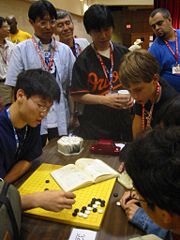
In Go, rank indicates a player's skill in the game. Traditionally, ranks are measured using kyu and dan grades, a system which has also been adopted by many martial arts. More recently, mathematical rating systems similar to the Elo rating system have been introduced. Such rating systems often provide a mechanism for converting a rating to a kyu or dan grade. Kyu grades (abbreviated k) are considered student grades and decrease as playing level increases, meaning 1st kyu is the strongest available kyu grade. Dan grades (abbreviated d) are considered master grades, and increase from 1st dan to 7th dan. First dan equals a black belt in eastern martial arts using this system. Top players can attain a professional dan grade (abbreviated p), with the very best reaching 9th dan professional. The difference between each amateur rank is one handicap stone. For the professional ranks, the difference is roughly one handicap stone for every three ranks. For example, if a 5k plays a game with a 1k, the 5k would need a handicap of four stones to even the odds. Top level amateur players sometimes defeat professionals in tournament play.
The rank system comprises, from the lowest to highest ranks:
| Rank Type | Range | Stage |
|---|---|---|
| Double-digit kyu | 30–20k | Beginner |
| Double-digit kyu (abbreviated: DDK) | 20–10k | Casual Player |
| Single-digit kyu (abbreviated: SDK) | 9–1k | Intermediate Player |
| Amateur dan | 1–7d (where 8d is special title) | Expert Player |
| Professional dan | 1–9p (where 10p is special title) | Professionals |
Tournament and match rules
Tournament and match rules deal with factors that may influence the game but are not part of the actual rules of play. Such rules may differ between events. Rules that influence the game include: the setting of compensation points (komi), handicap strategies, and time control parameters. Rules that do not generally influence the game are: the tournament system, pairing strategies, and placement criteria.
Common tournament systems used in Go include the McMahon system, Swiss system, league systems and the knockout system. Tournaments may combine multiple systems; many professional Go tournaments use a combination of the league and knockout systems.
Tournament rules may also set the following:
- compensation points, called komi, which compensate the second player for the first move advantage of his opponent; Tournaments commonly use a compensation in the range of 5–8 points, generally including a half-point to prevent draws.
- compensation stones placed on the board before alternate play, allowing players of different strengths to play competitively (see Go handicap for more information);
- superko: Although the basic ko rule described above covers over 95% of all cycles occurring in games, there are some complex situations —triple ko, eternal life, etc.— that are not covered by it but would allow the game to cycle indefinitely. To prevent this, the ko rule is sometimes extended to disallow any previous position. This is called superko.
Top players
Although the game was developed in China, the establishment of the Four Go houses by Tokugawa Ieyasu at the start of the 17th century shifted the focus of the Go world to Japan. State sponsorship, allowing players to dedicate themselves full-time to study of the game, and fierce competition between individual houses resulted in a significant increase in the level of play. During this period, the best player of his generation was given the prestigious title Meijin (master) and the post of Godokoro (minister of Go). Of special note are the players that were dubbed Kisei (Go Sage). The only three players to receive this honour were Dosaku, Jowa and Shusaku, all of the house Honinbo.
After the end of the Tokugawa Shogunate and the Meiji Restoration period, the Go houses slowly disappeared, and in 1924, the Nihon Kiin (Japanese Go Association) was formed. Top players from this period often played newspaper-sponsored matches of 2–10 games. Of special note are Go Seigen (Chinese: Wu Qingyuan), who scored an impressive 80% in these matches, and Kitani Minoru, who dominated matches in the early 1930s. These two players are also recognized for their groundbreaking work on new opening theory ( Shinfuseki).
For much of the twentieth century, Go continued to be dominated by players trained in Japan. Notable names included Sakata Eio, Rin Kaiho (Chinese: Lin Haifeng), Kato Masao, Kobayashi Koichi and Cho Chikun (born Cho Ch'i-hun, South Korea). As these names show, top Chinese and Korean talents would sometimes move to Japan, because the level of play there was high and funding was more lavish. One of the first Korean players to do so was Cho Namchul, who studied in the Kitani Dojo 1937–1944. After his return to Korea, the Hanguk Kiwon (Korean Go Association) was formed and caused the level of play in South Korea to rise significantly in the second half of the twentieth century. In China, the game suffered from the Cultural Revolution (1966-1976) but quickly recovered in the last quarter of the twentieth century, bringing Chinese players like Nie Weiping and Ma Xiaochun on par with their Japanese and Korean counterparts.
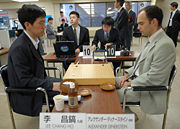
With the advent of major international titles from 1989 onward, it became possible to compare the level of players from different countries more accurately. Korean players like Lee Chang-ho, Cho Hunhyun, Lee Sedol and Park Young-Hoon dominated international Go and won an impressive number of titles. Several Chinese players also rose to the top in international Go, most notably Ma Xiaochun, Chang Hao and Gu Li. Japan currently lags behind in the international Go scene.
Historically, as with most sports and games, more men than women have played Go. Special tournaments for women exist, but until recently, men and women did not compete together at the highest levels. However, the creation of new, open tournaments and the rise of strong female players, most notably Rui Naiwei, have in recent years highlighted the strength and competitiveness of emerging female players.
The level in other countries has traditionally been much lower, except for some players who had preparatory professional training in Asia. Knowledge of the game has been scant elsewhere for most of the game's history. A German scientist, Oskar Korschelt, is credited with the first systematic description of the game in a Western language in 1880. A famous player of the 1920s was Emanuel Lasker, a former world chess champion during that time. It was not until the 1950s that more than a few Western players took up the game as other than a passing interest. In 1978, Manfred Wimmer became the first Westerner to receive a professional player's certificate from an Asian professional Go association. In 2000, a Westerner, Michael Redmond, finally achieved the top rank awarded by an Asian Go association, 9 dan. In total, as of 2008, only nine non-Asian Go players have ever turned professional.
Tactics
In Go, tactics deal with immediate fighting between stones, capturing and saving stones, life, death and other issues localized to a specific part of the board. Larger issues, not limited to only part of the board, are referred to as strategy, and are covered in their own section.
Capturing tactics
There are several tactical constructs aimed at capturing stones. These are among the first things a player learns after understanding the rules. Recognizing the possibility that stones can be captured using these techniques is an important step forward.
The most basic technique is the ladder. To capture stones in a ladder, a player uses a constant series of capture threats —called atari— to force the opponent into a zigzag pattern as shown in the diagram to the right. Unless the pattern runs into stones along the way, the stones in the ladder cannot avoid capture. Experienced players will recognize the futility of continuing the pattern and will play elsewhere. The presence of a ladder on the board does give a player the option to play a stone in the path of the ladder, thereby threatening to rescue his stones, forcing a response. Such a move is called a ladder breaker and may be a powerful strategic move.
Another technique to capture stones is the so-called net, also known by its Japanese name, geta. This refers to a move that loosely surrounds some stones, preventing their escape in all directions. An example is given in the diagram to the left. It is generally better to capture stones in a net than in a ladder, because a net does not depend on the condition that there are no opposing stones in the way, nor does it allow the opponent to play a strategic ladder breaker.
A third technique to capture stones is the snapback. In a snapback, a player sacrifices a stone in order to immediately capture several opposing stones, in effect snapping back those stones. An example can be seen on the right. As with the ladder, an experienced player will not play out such a sequence, recognizing the futility of capturing only to be captured back immediately.
Reading ahead
One of the most important skills required for strong tactical play is the ability to read ahead. Reading ahead consists of considering available moves to play, considering the possible responses to each move, the subsequent possibilities after each of those responses, etcetera. Some of the strongest players of the game can read up to 40 moves ahead even in complicated positions.
As explained in the section on important consequences of the basic rules, some formations of stones can never be captured and are said to be alive, while other stones may be in the position where they cannot avoid being captured and are said to be dead. Much of the practice material available to students of the game comes in the form of life and death problems, also known as tsumego. In such problems, players are challenged to find the vital move sequence that will kill a group of the opponent or save a group of their own. Tsumego are considered an excellent way to train a player's ability at reading ahead, and are available for all skill levels, some posing a challenge even to top players.
Ko fighting
In situations where the ko rule applies, prohibiting a player to capture to avoid repetition, a ko fight may occur. If the player who is prohibited from capture is of the opinion that the capture is important, for example because it prevents a large group of stones from being captured, the player may play a ko threat. This is a move elsewhere on the board that threatens to make a large profit if the opponent does not respond. If the opponent does respond to the ko threat, the situation on the board has changed, and the prohibition on capturing the ko no longer applies. Thus the player who made the ko threat may now recapture the ko. His opponent is then in the same situation, and can either play a ko threat as well, or concede the ko by simply playing elsewhere. If a player concedes the ko, either because he does not think it important, or because there are no moves left that could function as a ko threat, he has lost the ko, and his opponent may connect the ko.
Instead of responding to a ko threat, a player may also choose to ignore the threat and connect the ko. He thereby wins the ko, but at a cost. The choice of when to respond to a threat and when to ignore it is a subtle one, which requires a player to consider many factors, including how much is gained by connecting, how much is lost by not responding, how many possible ko threats both players have remaining, what the optimal order of playing them is, and what the size —points lost or gained— of each of the remaining threats is.
Frequently, the winner of the ko fight does not connect the ko but instead captures one of the chains which constituted his opponent's side of the ko. In some cases, this leads to another ko fight at a neighboring location.
Strategy
Strategy deals with global influence, interaction between distant stones, with keeping the whole board in mind during local fights and other issues that involve the overall game. It is therefore possible to allow a tactical loss when it confers a strategic advantage.
Go is not easy to play well. With each new level (rank) comes a deeper appreciation for the subtlety and nuances involved and for the insight of stronger players. The acquisition of major concepts of the game comes slowly. Novices often start by randomly placing stones on the board, as if it were a game of chance; they inevitably lose to experienced players who know how to create effective formations. An understanding of how stones connect for greater power develops, and then a few basic common opening sequences may be understood. Learning the ways of life and death helps in a fundamental way to develop one's strategic understanding of weak groups. It is necessary to play some thousands of games before one can get close to one's ultimate potential Go skill. A player who both plays aggressively and can handle adversity is said to display kiai or fighting spirit in the game.
Familiarity with the board shows first the tactical importance of the edges, and then the efficiency of developing in the corners first, then sides, then centre. The more advanced beginner understands that territory and influence are somewhat interchangeable—but there needs to be a balance. This intricate struggle of power and control makes the game highly dynamic.
Basic concepts
Basic strategic aspects include the following:
- Connection: Keeping one's own stones connected means that fewer groups need defense.
- Cut: Keeping opposing stones disconnected means that the opponent needs to defend more groups.
- Life: This is the ability of stones to permanently avoid capture. The simplest way is for the group to surround two eyes (separate empty areas), so that filling one eye will not kill the group and therefore be suicidal.
- Death: The absence of life coupled with the inability to create it, resulting in the eventual removal of a group.
- Invasion: Setting up a new living position inside an area where the opponent has greater influence, as a means of balancing territory.
- Reduction: Placing a stone far enough into the opponent's area of influence to reduce the amount of territory he/she will eventually get, but not so far in that it can be cut off from friendly stones outside.
- Sente: Play which makes your opponent respond ( gote), giving you control of the game.
The strategy involved can become very abstract and complex. High-level players spend years improving their understanding of strategy.
Opening strategy
In the opening of the game, players will usually play in the corners of the board first, as the presence of two edges make it easier for a player to surround territory and establish his stones. After the corners, focus moves to the sides, where there is still one edge to support a player's stones. Opening moves are generally on the third and fourth line from the edge, with occasional moves on the second and fifth lines. In general, stones on the third line offer stability and are good defensive moves, whereas stones on the fourth line influence more of the board and are good attacking moves.
In the opening, players often play established sequences called joseki, which are locally balanced exchanges. However the joseki chosen should also produce a satisfactory result on a global scale. It is generally advisable to keep a balance between stability and influence. Which of these gets precedence is often a matter of individual taste.
Computers and Go
Nature of the game
In combinatorial game theory terms, Go is a zero-sum, perfect information, partisan, deterministic strategy game, putting it in the same class as chess, checkers (draughts), and reversi (othello), but it is not similar in its play to these. Although the game rules are simple, the practical strategy is extremely complex.
The game emphasizes the importance of balance on multiple levels and has internal tensions. To secure an area of the board, it is good to play moves close together; but to cover the largest area, one needs to spread out, perhaps leaving weaknesses that can be exploited. Playing too low (close to the edge) secures insufficient territory and influence; yet playing too high (far from the edge) allows the opponent to invade.
It has been claimed that Go is the most complex game in the world because of its vast number of variations in individual games. Its large board and lack of restrictions allow great scope in strategy and expression of players' individuality. Decisions in one part of the board may be influenced by an apparently unrelated situation in a distant part of the board. Plays made early in the game can shape the nature of conflict a hundred moves later.
The game complexity of Go is such that describing even elementary strategy fills many introductory books. In fact, numerical estimates show that the number of possible games of Go far exceeds the number of atoms in the known universe.
Software players
Go poses a daunting challenge to computer programmers. While the strongest computer chess software has defeated top players (for example, the IBM computer Deep Blue beat Garry Kasparov, the then-world champion in 1997), the best Go programs only manage to reach an intermediate amateur level. On the small 9×9 board, the computer fares better, and some programs have reached a strong amateur level. Human players generally achieve an intermediate amateur level by studying and playing regularly for a few years. Many in the field of artificial intelligence consider Go to require more elements that mimic human thought than chess.
The reasons why computer programs do not play Go well are attributed to many qualities of the game, including:
- The area of the board is very large (more than five times the size of a chess board). Throughout most of the game, the number of legal moves stays at around 150–250 per turn, and rarely goes below 50 (compare chess, where the average number of moves is 37). Because an exhaustive computer program for Go must calculate and compare every possible legal move in each ply (player turn), its ability to work out favorable lines of play is sharply reduced when there are a large number of possible moves.
- In capture-based games (like chess), a position can often be evaluated relatively easily, such as by calculating who has a material advantage or more active pieces. In Go, there is often no easy way to evaluate a position. The number of stones on the board (material advantage) is only a weak indicator of the strength of a position; and a territorial advantage (more empty points surrounded) for one player might be compensated by the opponent's strong positions and influence all over the board. And the global value is not a simple function of local values.
- There is a very high degree of pattern recognition involved in human play. Intuition is thought to be one of the most important skills that a Go player should develop.
Software assistance
Beyond programs that play Go, there is an abundance of software available to support players of the game. This includes programs that can be used to view and/or edit game records and diagrams, programs that allow the user to search for patterns in the games of strong players and programs that allow users to play against each other over the Internet.
There are several file formats used to store game records, the most popular of which is SGF, short for Smart Game Format. Programs used for editing game records allow the user to record not just the moves, but also variations, commentary and further information on the game.
Electronic databases can be used to study life and death situations, joseki, fuseki and games by a particular player. Programs are available that give players pattern searching options, which allow players to research positions by searching for high level games in which similar situations occur. Such software generally lists common follow-up moves that have been played by professionals and gives statistics on win/loss ratio in opening situations.
Many Internet-based Go servers allow access to competition with players all over the world. Such servers also allow easy access to professional teaching, with both teaching games and interactive game review being possible.
In culture and science
Literature and film
Apart from technical literature and study material, Go and its strategies have also been the subject of several non-technical books, such as the novel The Master of Go by Nobel prize-winning author Yasunari Kawabata. Other books have used Go as a theme or minor plot device. For example, the 1979 novel Shibumi by Trevanian centers around the game and uses Go metaphors.
Similarly, Go has been used as a subject or plot device in film, such as π ( Pi), the Academy Award-winning film A Beautiful Mind, or The Go Master, a biopic of Go professional Go Seigen.
Of particular note is the manga (Japanese comic) and anime series Hikaru no Go, released in Japan in 1998, which had a large impact in popularizing Go among young players, both in Japan and —as translations were released— abroad.
Philosophy
Often, a comparison of Go and chess is used as a parallel to explain Western versus Eastern strategic thinking (despite the fact that both Go and chess originate in Asia; Western chess is significantly different). Go begins with an empty board. It is focused on building from the ground up (nothing to something) with multiple, simultaneous battles leading to a point-based win. Chess, one can say, is in the end centralised, as the predetermined object is to kill one individual piece (the king). Go is quite the opposite; individual stones are only significant as part of larger groups, and the effect of those groups is determined only as the game proceeds. This comparison has also been applied to military and political history, with Scott Boorman's 1969 book The Protracted Game exploring the strategy of the Communist Party of China in the Chinese Civil War through the lens of Go.
A similar comparison has been drawn among Go, chess and backgammon, perhaps the three oldest games that still enjoy worldwide popularity. Backgammon is a "man vs. fate" contest, with chance playing a strong role in determining the outcome. Chess, with rows of soldiers marching forward to capture each other, embodies the conflict of "man vs. man". Because the handicap system tells each Go player where he/she stands relative to other players, an honestly ranked player can expect to lose about half of his/her games; therefore, Go can be seen as embodying the quest for self-improvement—"man vs. self".
Psychology
A recent review of literature by Gobet, de Voogt & Retschitzki (2004) shows that relatively little scientific research has been carried out on the psychology of Go, compared to other traditional board games such as chess and mancala. Given the large search tree, knowledge and pattern recognition seem to be more important than look-ahead search. A study of the effects of age on Go playing has shown that decline is milder with strong players than with weaker players. According to the review of Gobet and colleagues, the pattern of brain activity observed with techniques such as PET and fMRI does not show large differences between Go and chess, probably due to the fact that both games engage pattern recognition mechanisms. On the other hand, a study by Xiangchuan Chen et al. showed greater activation in the right hemisphere among Go players than among chess players, which suggests that Go calls upon intuitive functions more. There is some evidence to suggest a correlation between playing board games (including Go) and reduced risk of Alzheimer's disease and dementia.
